HP 315, 365, 335, 375 User Guide

HP Latex 300 Printer Series
User Guide
Edition 5 |
Legal notices |
© 2016–2020 HP Development Company, L.P. |
The information contained herein is subject to |
|
change without notice. |
|
The only warranties for HP products and |
|
services are set forth in the express warranty |
|
statements accompanying such products and |
|
services. Nothing herein should be construed as |
|
constituting an additional warranty. HP shall not |
|
be liable for technical or editorial errors or |
|
omissions contained herein. |
Trademarks
Microsoft® and Windows® are U.S. registered trademarks of Microsoft Corporation.

Table of contents
1 Introduction ............................................................................................................................................................................................... |
1 |
Welcome to your printer .......................................................................................................................................................... |
2 |
Printer models .......................................................................................................................................................................... |
2 |
Documentation ......................................................................................................................................................................... |
3 |
Safety precautions ................................................................................................................................................................... |
3 |
Main printer components ........................................................................................................................................................ |
8 |
Front panel .............................................................................................................................................................................. |
11 |
HP Latex Mobile ...................................................................................................................................................................... |
20 |
Embedded Web Server .......................................................................................................................................................... |
22 |
Connectivity and software instructions .............................................................................................................................. |
28 |
Advanced network configuration ......................................................................................................................................... |
30 |
Turn the printer on and off ................................................................................................................................................... |
36 |
Restart the printer .................................................................................................................................................................. |
37 |
2 Useful links .............................................................................................................................................................................................. |
38 |
When you need help .............................................................................................................................................................. |
38 |
3 Handle the substrate and troubleshoot substrate issues ................................................................................................................ |
40 |
Overview .................................................................................................................................................................................. |
42 |
Porous substrates .................................................................................................................................................................. |
46 |
Load a roll onto the spindle .................................................................................................................................................. |
47 |
Load a roll into the printer .................................................................................................................................................... |
52 |
Ink collector (365 and 375 only) .......................................................................................................................................... |
55 |
Loading accessory (365 and 375 only) ............................................................................................................................... |
59 |
Assisted manual load ............................................................................................................................................................ |
63 |
Edge holders ........................................................................................................................................................................... |
65 |
Load a cut sheet into the printer ......................................................................................................................................... |
67 |
Unload a roll from the printer .............................................................................................................................................. |
68 |
Take-up reel ............................................................................................................................................................................ |
69 |
Double-sided printing (365 and 375 only) ......................................................................................................................... |
77 |
View information about the substrate ................................................................................................................................ |
78 |
Change substrate width and right edge position .............................................................................................................. |
79 |
Substrate length tracking ..................................................................................................................................................... |
79 |
Cut substrate .......................................................................................................................................................................... |
79 |
ENWW |
iii |
Bypass job start safety .......................................................................................................................................................... |
80 |
Store the substrate ................................................................................................................................................................ |
80 |
Substrate cannot be loaded successfully ........................................................................................................................... |
80 |
Substrate is mispositioned ................................................................................................................................................... |
81 |
Substrate has jammed .......................................................................................................................................................... |
81 |
Substrate is deformed or wrinkled ...................................................................................................................................... |
84 |
Substrate has shrunk or expanded ..................................................................................................................................... |
84 |
Substrate has bow deformation .......................................................................................................................................... |
85 |
Substrate is sticky and causes smears and crashes ........................................................................................................ |
86 |
Automatic cutter does not work .......................................................................................................................................... |
86 |
Take-up reel substrate jam ................................................................................................................................................... |
86 |
Take-up reel does not wind .................................................................................................................................................. |
86 |
4 Substrate settings .................................................................................................................................................................................. |
88 |
Substrate presets ................................................................................................................................................................... |
89 |
Online search .......................................................................................................................................................................... |
89 |
HP Media Locator ................................................................................................................................................................... |
91 |
Generic presets ....................................................................................................................................................................... |
92 |
Clone a substrate preset ....................................................................................................................................................... |
92 |
Modify a substrate preset ..................................................................................................................................................... |
93 |
Add a new substrate .............................................................................................................................................................. |
94 |
Delete a substrate preset ..................................................................................................................................................... |
98 |
Faster printing ......................................................................................................................................................................... |
98 |
Color calibration ...................................................................................................................................................................... |
99 |
Color consistency between different printers (365, 375) ............................................................................................. |
103 |
ICC profiles ............................................................................................................................................................................. |
103 |
Improve color consistency when tiling ............................................................................................................................. |
104 |
5 Troubleshoot print-quality issues ..................................................................................................................................................... |
107 |
General printing advice ....................................................................................................................................................... |
108 |
Quick Solutions application (365 and 375 only) ............................................................................................................. |
108 |
Improve print quality ........................................................................................................................................................... |
109 |
Most-common print-quality problems ............................................................................................................................. |
115 |
6 Ink system ............................................................................................................................................................................................. |
125 |
Ink cartridges ........................................................................................................................................................................ |
126 |
Printheads ............................................................................................................................................................................. |
126 |
Maintenance cartridge ........................................................................................................................................................ |
127 |
Safe mode ............................................................................................................................................................................. |
127 |
7 Hardware maintenance ....................................................................................................................................................................... |
129 |
Ink system tips ..................................................................................................................................................................... |
130 |
Maintain the ink cartridges ................................................................................................................................................. |
130 |
iv |
ENWW |
Replace an ink cartridge ..................................................................................................................................................... |
130 |
Cannot insert an ink cartridge ........................................................................................................................................... |
134 |
Clean (recover) the printheads ........................................................................................................................................... |
134 |
Align the printheads ............................................................................................................................................................ |
135 |
Front panel recommends reseating or replacing a printhead ...................................................................................... |
137 |
Replace a printhead ............................................................................................................................................................. |
137 |
Cannot insert a printhead ................................................................................................................................................... |
143 |
Clean the electrical connections on a printhead ............................................................................................................. |
144 |
Replace the maintenance cartridge .................................................................................................................................. |
148 |
Cannot insert the maintenance cartridge ........................................................................................................................ |
151 |
Clean and lubricate the carriage rod ................................................................................................................................. |
151 |
Clean the encoder strip ....................................................................................................................................................... |
153 |
Clean the platen ................................................................................................................................................................... |
154 |
Clean the substrate-advance sensor window ................................................................................................................. |
155 |
Clean the exterior of the printer ........................................................................................................................................ |
156 |
Move or store the printer .................................................................................................................................................... |
156 |
Service maintenance ........................................................................................................................................................... |
157 |
8 Firmware update .................................................................................................................................................................................. |
158 |
Firmware update using a USB flash drive ........................................................................................................................ |
158 |
Firmware update using the Embedded Web Server ...................................................................................................... |
159 |
Automatic firmware updates ............................................................................................................................................. |
159 |
9 Accessories ............................................................................................................................................................................................ |
160 |
Order ink supplies ................................................................................................................................................................ |
160 |
Order accessories ................................................................................................................................................................ |
162 |
10 Troubleshoot other issues ............................................................................................................................................................... |
163 |
Printer cannot get an IP address ....................................................................................................................................... |
164 |
Cannot access the Embedded Web Server ...................................................................................................................... |
164 |
Printer is not printing .......................................................................................................................................................... |
164 |
The software program slows down or stalls while generating the print job ............................................................. |
165 |
Printer seems slow .............................................................................................................................................................. |
165 |
Communication failures between computer and printer .............................................................................................. |
166 |
Cannot connect to services such as firmware update, online search, or the Printer Data Sharing Agreement ... |
166 |
Front-panel error codes ...................................................................................................................................................... |
167 |
11 Printer specifications ......................................................................................................................................................................... |
173 |
Functional specifications .................................................................................................................................................... |
174 |
Physical specifications ........................................................................................................................................................ |
175 |
Memory specifications ........................................................................................................................................................ |
176 |
Power specifications ............................................................................................................................................................ |
176 |
Ecological specifications ..................................................................................................................................................... |
176 |
ENWW |
v |
Environmental specifications ............................................................................................................................................. |
176 |
Acoustic specifications ........................................................................................................................................................ |
177 |
Appendix A Summary of common printing problems ....................................................................................................................... |
178 |
Glossary ..................................................................................................................................................................................................... |
181 |
Index ........................................................................................................................................................................................................... |
184 |
vi |
ENWW |

1Introduction
●Welcome to your printer
●Printer models
●Documentation
●Safety precautions
●Main printer components
●Front panel
●HP Latex Mobile
●Embedded Web Server
●Connectivity and software instructions
●Advanced network configuration
●Turn the printer on and off
●Restart the printer
ENWW |
1 |

Welcome to your printer
Your printer is a color inkjet printer designed for printing high-quality images on flexible substrates. Some major features of the printer are shown below:
●Odorless, water-based latex inks in six colors plus optimizer
●775 ml ink cartridges (3-liter cartridges for the 375 printer)
●Sharpest print quality, smooth transitions, and fine details with 1200 real dpi
●Consistent and repeatable print quality at every print speed
●Prints are completely dry and ready for finishing and delivery
●Print on a wide range of substrates—including most low-cost, uncoated, solvent-compatible substrates
●A range of HP recyclable substrates is available
●Consider un-laminated use with scratch resistance comparable to hard solvent inks on SAV and PVC banners
●Durable prints with outdoor display permanence up to three years unlaminated, five years laminated
●Hundreds of ready-made substrate presets easily available
To send print jobs to your printer, you will need Raster Image Processor (RIP) software, which should be run on a separate computer. RIP software is available from various different companies.
Printer models
HP Latex 315 |
HP Latex 335 |
HP Latex 365 |
HP Latex 375 |
|
|
|
|
Supplied with the printer |
HP Latex 64-in Take-Up |
HP Latex 64-in Take-Up |
HP Latex 64-in Take-Up |
|
Reel |
Reel |
Reel |
|
|
|
|
HP Latex 54-in Printer 2- |
HP Latex 64-in Printer 2- |
HP Latex 64-in Printer 3- |
HP Latex 64-in Printer 3- |
in Spindle (including 2- to |
in Spindle (including 2- to |
in Spindle |
in Spindle |
3-in spindle adaptor) |
3-in spindle adaptor) |
|
|
|
|
|
|
|
|
HP Latex Substrate- |
HP Latex Substrate- |
|
|
Loading Accessory |
Loading Accessory |
|
|
|
|
HP Latex 300/500 User |
HP Latex 300/500 User |
HP Latex 300/500 User |
HP Latex 300/500 User |
Maintenance Kit |
Maintenance Kit |
Maintenance Kit |
Maintenance Kit |
|
|
|
|
FlexiPRINT HP Basic |
FlexiPRINT HP Basic |
|
|
Edition |
Edition |
|
|
HP Latex 300/500 Ink Collector (including output platen protector)
HP Latex 300/500 Ink Collector (including output platen protector)
Optional accessories |
HP Latex 300 54-in Take- |
|
|
|
|
Up Reel (including 2-in |
|
|
|
|
reel with 3-in adaptor |
|
|
|
|
and Variable Front |
|
|
|
|
Tension Kit) |
|
|
|
|
|
|
|
|
|
HP Latex 54-in Printer 2- |
HP Latex 64-in Printer 2- |
HP Latex 64-in Printer 2- |
HP Latex 64-in Printer 2- |
|
in Spindle (including 2- to |
in Spindle (including 2- to |
in Spindle (including 2- to |
in Spindle (including 2- to |
|
3-in spindle adaptor) |
3-in spindle adaptor) |
3-in spindle adaptor) |
3-in spindle adaptor) |
|
|
|
|
|
|
|
HP Latex 64-in Printer 3- |
HP Latex 64-in Printer 3- |
HP Latex 64-in Printer 3- |
|
|
in Spindle |
in Spindle |
in Spindle |
|
|
|
|
|
2 Chapter 1 Introduction |
ENWW |

HP Latex 315 |
HP Latex 335 |
HP Latex 365 |
HP Latex 375 |
|
|
|
|
HP Latex 300/500 User |
HP Latex 300/500 User |
HP Latex 300/500 User |
HP Latex 300/500 User |
Maintenance Kit |
Maintenance Kit |
Maintenance Kit |
Maintenance Kit |
HP Latex 300/500 Ink Collector (including the consumable parts)
HP Latex 300/500 Ink Collector (including the consumable parts)
Consumables |
HP 831 Latex Printheads |
HP 831 Latex Printheads |
HP 831 Latex Printheads |
HP 831 Latex Printheads |
|
(1 set included in box) |
(1 set included in box) |
(1 set included in box) |
(1 set included in box) |
|
|
|
|
|
|
HP 831 Latex Ink |
HP 831 Latex Ink |
HP 831 Latex Ink |
HP 831 Latex Ink |
|
Cartridges |
Cartridges |
Cartridges |
Cartridges |
|
|
|
|
|
|
|
|
|
HP 871 3-liter Ink |
|
|
|
|
Cartridges |
|
|
|
|
|
|
HP 831 Latex |
HP 831 Latex |
HP 831 Latex |
HP 831 Latex |
|
Maintenance Cartridge (1 |
Maintenance Cartridge (1 |
Maintenance Cartridge (1 |
Maintenance Cartridge (1 |
|
included in box) |
included in box) |
included in box) |
included in box) |
|
|
|
|
|
Documentation
The following documents can be downloaded from http://www.hp.com/go/latex300/manuals/:
●Introductory information
●Printer assembly instructions
●User guide
●Legal information
●Limited warranty
The Quick Response (QR) code images found in some parts of this user guide provide links to additional video explanations of particular topics. For an example of such an image, see Main printer components on page 8.
Safety precautions
Before using your printer, read the following safety precautions to make sure you use the equipment safely.
You are expected to have the appropriate technical training and experience necessary to be aware of hazards to which you may be exposed in performing a task, and take appropriate measures to minimize the risks to yourself and to other people.
General safety guidelines
There are no operator-serviceable parts inside the printer except those covered by HP's Customer Self Repair program (see http://www.hp.com/go/selfrepair/). Refer servicing of other parts to qualified service personnel.
Turn off the printer and call your service representative in any of the following cases:
●The power cord or plug is damaged.
●The curing enclosures are damaged.
●The printer has been damaged by an impact.
●There is any mechanical or enclosure damage.
●Liquid has entered the printer.
ENWW |
Documentation 3 |

●There is smoke or an unusual smell coming from the printer.
●The printer has been dropped or the curing module has been damaged.
●The printer is not operating normally.
Turn off the printer in either of the following cases:
●During a thunderstorm
●During a power failure
Take special care with zones marked with warning labels.
Electrical shock hazard
 WARNING! The internal circuits of curing zones, output drier, print-zone heaters, and built-in power supplies operate at hazardous voltages capable of causing death or serious personal injury.
WARNING! The internal circuits of curing zones, output drier, print-zone heaters, and built-in power supplies operate at hazardous voltages capable of causing death or serious personal injury.
The printer uses two power cords. Unplug both power cords before servicing the printer.
To avoid the risk of electric shock:
●The printer must be connected to earthed mains outlets only.
●Do not attempt to dismantle the curing modules.
●Do not remove or open any other closed system covers or plugs.
●Do not insert objects through slots in the printer.
Heat hazard
The curing subsystems of the printer operate at high temperatures and can cause burns if touched. To avoid personal injury, take the following precautions.
●Do not touch the internal enclosures of the printer's curing zones.
●Let the printer cool down when accessing the internal curing zone and output platen in case of a substrate jam.
●Let the printer cool down before performing some maintenance operations.
Fire hazard
The curing subsystems of the printer operate at high temperatures.
To avoid the risk of fire, take the following precautions.
●The customer is responsible for meeting the printer's requirements and the Electrical Code requirements according to the local jurisdiction of the country where the equipment is installed. Use the power supply voltage specified on the nameplate.
●Connect the power cords to dedicated lines, each protected by a branch circuit breaker according to the information detailed in the site preparation guide. Do not use a power strip (relocatable power tap) to connect both power cords.
●Use only the power cords supplied by HP with the printer. Do not use a damaged power cord. Do not use the power cords with other products.
●Do not insert objects through slots in the printer.
4 Chapter 1 Introduction |
ENWW |

●Take care not to spill liquid on the printer. After cleaning, make sure all components are dry before using the printer again.
●Do not use aerosol products that contain flammable gases inside or around the printer. Do not operate the printer in an explosive atmosphere.
●Do not block or cover the openings of the printer.
●Do not attempt to dismantle or modify the curing modules.
●Ensure that the operating temperature of the substrate recommended by the manufacturer is not exceeded. If this information is not available, ask the manufacturer. Do not load substrates that cannot be used at an operating temperature above 125°C (257°F).
●Do not load substrates with auto-ignition temperatures below 250°C (482°F). If this information is not available, printing must be supervised at all times. See note below.
 NOTE: Test method based on EN ISO 6942:2002; Evaluation of materials and material assemblies when exposed to a source of radiant heat, method B. The test conditions, to determine the temperature when the substrate starts ignition (either flame or glow), were: Heat flux density 30 kW/m², copper calorimeter, K type thermocouple.
NOTE: Test method based on EN ISO 6942:2002; Evaluation of materials and material assemblies when exposed to a source of radiant heat, method B. The test conditions, to determine the temperature when the substrate starts ignition (either flame or glow), were: Heat flux density 30 kW/m², copper calorimeter, K type thermocouple.
Mechanical hazard
The printer has moving parts that could cause injury. To avoid personal injury, take the following precautions when working close to the printer.
●Keep your clothing and all parts of your body away from the printer's moving parts.
●Avoid wearing necklaces, bracelets, and other hanging objects.
●If your hair is long, try to secure it so that it will not fall into the printer.
●Take care that sleeves or gloves do not get caught in the printer's moving parts.
●Avoid standing close to the fans, which could cause injury and could also affect print quality (by obstructing the air flow).
●Do not touch gears or moving rolls during printing.
●Do not operate the printer with covers bypassed.
Light radiation hazard
Light radiation is emitted from the illumination of the print zone. This illumination is in compliance with the requirements of the exempt group of IEC 62471:2006, Photobiological safety of lamps and lamp systems. However, you are recommended not to look directly at the LEDs while they are on. Do not modify the module.
Chemical hazard
See the safety data sheets available at http://www.hp.com/go/msds to identify the chemical ingredients of your consumables. Sufficient ventilation should be provided to ensure that potential airborne exposure to these substances is adequately controlled. Consult your usual air-conditioning or EHS specialist for advice on the appropriate measures for your location. For more detailed information, see the “Ventilation” and “Air conditioning” sections of the site preparation guide, available from http://www.hp.com/go/latex300/manuals/.
Ventilation
Ensure that the room in which the system is installed meets local environmental, health, and safety (EHS) guidelines and regulations.
ENWW |
Safety precautions 5 |
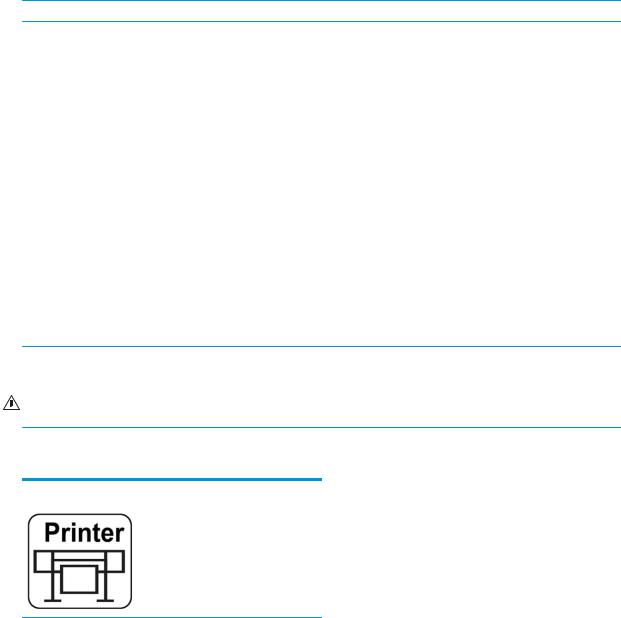
Adequate ventilation needs to be provided to ensure that potential exposure is adequately controlled. Consult the Safety Data Sheets available at http://www.hp.com/go/msds to identify chemical ingredients of your ink consumables. Levels of certain substances in your environment are dependent on workspace variables you control, such as room size, ventilation performance, and duration of equipment use. Consult your EHS specialist for advice on the appropriate measures for your location.
Air conditioning
In addition to fresh air ventilation, to avoid health hazards, consider maintaining workplace ambient levels by ensuring the climatic operating conditions specified in this document (see Environmental specifications
on page 176) to avoid operator discomfort and equipment malfunction. Air conditioning in the work area should take into account that the equipment produces heat. Typically, the printer's power dissipation is:
●2.2 kW (7.5 kBTU/h) for HP Latex 315 printers
●2.6 kW (8.9 kBTU/h) for HP Latex 335 printers
●4.6 kW (15.7 kBTU/h) for HP Latex 365 and 375 printers
Air conditioning should meet local environmental, health, and safety (EHS) guidelines and regulations.
 CAUTION: The air conditioning units should not blow air directly onto the printer.
CAUTION: The air conditioning units should not blow air directly onto the printer.
Heavy substrate hazard
Special care must be taken to avoid personal injury when handling heavy substrates.
●Handling heavy substrate rolls may require more than one person. Care must be taken to avoid back strain and/or injury.
●Consider using a forklift, pallet truck, or other handling equipment.
●When handling heavy substrate rolls, wear personal protective equipment including boots and gloves.
Ink handling
HP recommends that you wear gloves when handling ink system components.
Warnings and cautions
The following symbols are used in this manual to ensure the proper use of the printer and to prevent the printer from being damaged. Follow the instructions marked with these symbols.
 WARNING! Failure to follow the guidelines marked with this symbol could result in serious personal injury or death.
WARNING! Failure to follow the guidelines marked with this symbol could result in serious personal injury or death.
CAUTION: Failure to follow the guidelines marked with this symbol could result in minor personal injury or damage to the printer.
Warning labels
Label |
Explanation |
|
|
|
Printer label. To identify the printer’s power cord. |
6 Chapter 1 Introduction |
ENWW |

Label |
Explanation |
|
|
|
Curing label. To identify the curing power cord. |
Electric shock hazard. Heating modules operate at hazardous voltages. Disconnect power source before servicing.
CAUTION: Double pole. Neutral fusing.
Equipment to be connected to earthed mains outlet only. Refer servicing to qualified service personnel. Disconnect all power cords before servicing. No operator serviceable parts inside the printer.
Before starting, read and follow the operating and safety instructions. Ensure that the input voltage is within the printer's rated voltage range. The printer requires up to two dedicated lines.
This label is located on the e-box.
Risk of burns. Do not touch the curing zone or the output platen of the printer: they could be hot.
This label is located on the front of the curing module.
Risk of trapped fingers. Do not touch moving gears.
These labels are located at the rear of the printer, one on the substrate input gear and one on the take-up reel gear (335, 365, and 375 only).
Moving part. Keep away from the moving printhead carriage. When printing, the printhead carriage travels back and forth across the substrate.
This label is located on the rear of the scan axis window, behind the plastic.
You are recommended to wear gloves when handling the maintenance cartridge, the platen, or the ink collector.
This label is located on the maintenance cartridge.
Electric shock hazard. Heating modules operate at hazardous voltages. Disconnect all power sources before servicing.
This label is located on the curing control PCA enclosure. For service personnel only.
ENWW |
Safety precautions 7 |
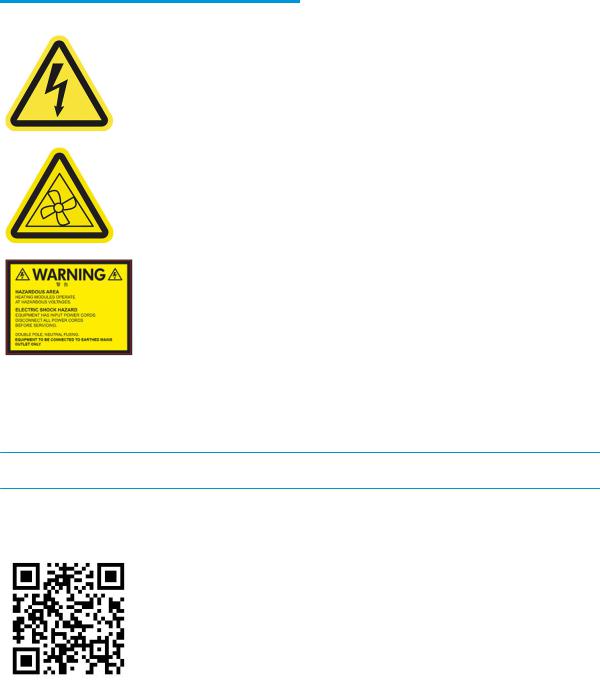
Label |
Explanation |
|
|
|
Electric shock hazard. The printer has two input power cords. Power |
|
supplies operate at hazardous voltages. Disconnect all power cords |
|
before servicing. |
|
This label is located internally (in the 365 and 375 only), close to the |
|
print-zone heating-coils enclosure between fans. For service |
|
personnel only. |
|
|
|
Hazardous moving parts. Rotating fan blades. Keep hands clear. |
|
These labels are located internally, close to the print-zone heating |
|
fans between fans (365 and 375 only), one near the vacuum fan |
|
and one near the aerosol fan. For service personnel only. |
|
|
|
Hazardous area. Heating modules operate at hazardous voltages. |
|
Electric shock hazard. Equipment has two input power cords. |
|
Disconnect all power cords before servicing. Power supplies operate |
|
at hazardous voltages. |
|
Double pole, neutral fusing. |
|
Equipment to be connected to earthed mains outlet only. |
|
This label is located in the scan and air-curtain heater control |
|
enclosure (365 and 375 only). For service personnel only. |
|
|
 NOTE: The final label position and its size on the printer may vary slightly, but should always be visible and close to the potential risk area.
NOTE: The final label position and its size on the printer may vary slightly, but should always be visible and close to the potential risk area.
Main printer components
The above image is a QR code containing a link to a video; see Documentation on page 3.
The following views of the printer illustrate its main components.
8 Chapter 1 Introduction |
ENWW |

Front view
1.Ink cartridge
2.Platen
3.Printhead
4.Printhead carriage
5.Front panel
6.Maintenance cartridge
7.Substrate pinch lever
8.Spindle lock lever
9.Take-up reel motor
10.Tension bar
11.Spindle
12.Take-up reel
13.Spindle stop
14.Loading table
15.Curing module
ENWW |
Main printer components 9 |
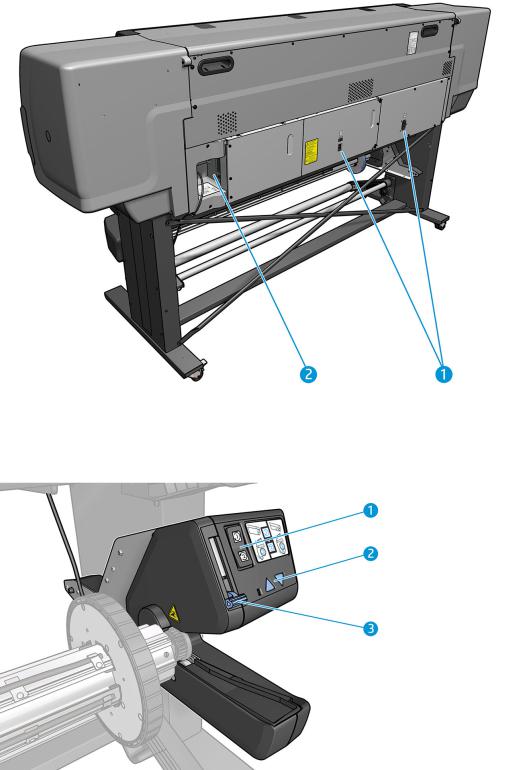
Rear view
1.Power switch and power socket
2.Sockets for communication cables and optional accessories
Take-up reel motor
1.Winding-direction switch
2.Manual winding buttons
3.Take-up reel lever
10 Chapter 1 Introduction |
ENWW |

Loading accessory
The loading accessory helps you to load some substrate types that are difficult to load without it. See Loading accessory (365 and 375 only) on page 59.
Front panel
Introduction to the front panel
The front panel is a touch-sensitive screen with a graphical user interface; it is located on the front right of the printer. It gives you complete control of your printer: from the front panel, you can view information about the printer, change printer settings, perform calibrations and tests, and so on. The front panel also displays alerts (warning and error messages) when necessary.
HP Latex 315/335 home screen
HP Latex 365/375 home screen
There is an alternative home screen that you can see by sliding your finger across the screen to the left. It summarizes the status of the ink cartridges, the substrate, and the current print job.
ENWW |
Front panel 11 |

The front panel has a large central area to display dynamic information and icons. On the left and right sides you can see up to six fixed icons at different times. Normally they are not all displayed at the same time.
Left and right fixed icons
●Press  to return to the home screen.
to return to the home screen.
●Press  to view help about the current screen.
to view help about the current screen.
●Press  to go to the previous item.
to go to the previous item.
●Press  to go to the next item.
to go to the next item.
●Press  to go back to the last-visited screen. This does not discard any changes made in the current screen.
to go back to the last-visited screen. This does not discard any changes made in the current screen.
●Press  to cancel the current process.
to cancel the current process.
Home screen dynamic icons
The following items are displayed only on the home screen.
●At the top left of the screen is a message showing the printer status or the most important current alert. Press this message to see a list of all current alerts, with an icon indicating the severity of each alert. You can press an alert to get help in solving the problem.
●At the top right, press  to turn on or off the print-zone illumination light.
to turn on or off the print-zone illumination light.
● |
Press |
to view substrate status and perform substrate-handling operations. |
● |
Press |
to open the Substrate Library and access the extensive online library of substrate presets. |
● |
Press |
to view information about the job that is currently printing. |
● |
Press |
to view ink-supply status and perform ink-cartridge and printhead operations. |
12 Chapter 1 Introduction |
ENWW |
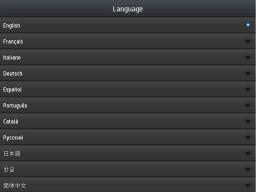
●Press  to find quick solutions to printing problems.
to find quick solutions to printing problems.
●Press  to view network and Internet status and change related settings.
to view network and Internet status and change related settings.
●Press  to view information about the printer.
to view information about the printer.
●Press  for help.
for help.
●Press  to view and change printer settings in general.
to view and change printer settings in general.
If the printer is left idle for some time, it goes into sleep mode and switches off the front-panel display. To change the time that elapses before sleep mode, press  , then Setup > Front panel options > Sleep mode wait time. You can set a time between 5 and 240 minutes; the default is 25 minutes.
, then Setup > Front panel options > Sleep mode wait time. You can set a time between 5 and 240 minutes; the default is 25 minutes.
The printer wakes from sleep mode and switches on the front-panel display whenever there is some external interaction with it.
Information about specific uses of the front panel can be found throughout this guide.
Change the language of the front panel
Two methods are available to change the language that is used for the front-panel menus and messages.
●If you can understand the current front panel language, go to the front panel and press  , then Setup > Front panel options > Language.
, then Setup > Front panel options > Language.
●If you cannot understand the current front panel language, start with the printer turned off. Turn it on. As
soon as the  icon appears, press it for a few seconds. When all icons have appeared on the front panel, press
icon appears, press it for a few seconds. When all icons have appeared on the front panel, press  followed by
followed by  . The front panel blinks briefly.
. The front panel blinks briefly.
Whichever method you used, the language selection menu should now appear on the front panel.
Press the name of your preferred language.
View or set the date and time
To view or set the printer's date and time, go to the front panel and press  , then Setup > Front panel options > Date and time options.
, then Setup > Front panel options > Date and time options.
ENWW |
Front panel 13 |
Set altitude
If your printer is operating at more than 500 m (1640 ft) above sea level, go to the front panel and press  , then Setup > Select altitude, to tell the printer its operating altitude.
, then Setup > Select altitude, to tell the printer its operating altitude.
Set time before standby
When there are no more jobs to print, or you want to pre-warm the printer (Prepare printing option in the RIP), the printer´s curing heaters remain on for the specified time and temperature in case another job arrives or in case you need to avoid any print-quality problem that could be caused by an incorrect temperature in the print
zone. To choose how long the heaters will stay on in this situation, go to the front panel and press  then Substrate > Substrate handling options > Curing standby duration. You can select from 5 to 120 minutes.
then Substrate > Substrate handling options > Curing standby duration. You can select from 5 to 120 minutes.
The curing temperature during this standby period is set automatically by the printer.
Change the sleep mode setting
If the printer is left turned on but unused for a certain period of time, it automatically goes into sleep mode to save power. The default period of time it waits is 25 minutes. To change the time the printer waits before it goes
into sleep mode, go to the front panel and press  , then Setup > Front panel options > Sleep mode wait time. Enter in minutes the wait time that you want, then press OK.
, then Setup > Front panel options > Sleep mode wait time. Enter in minutes the wait time that you want, then press OK.
Change the loudspeaker volume
To change the volume of the printer's loudspeaker, go to the front panel and press  , then Setup > Front panel options > Speaker volume, and select Off, Low, or High.
, then Setup > Front panel options > Speaker volume, and select Off, Low, or High.
Turn audio alerts on or off
To turn the printer's audio alerts on or off, go to the front panel and press  , then Setup > Front panel options > Enable audio alert or Disable audio alert. By default, audio alerts are enabled.
, then Setup > Front panel options > Enable audio alert or Disable audio alert. By default, audio alerts are enabled.
Change the front panel display brightness
To change the brightness of the front-panel display, press  , then Setup > Front panel options > Display brightness, then select a value by moving the scroll bar. Press OK to save the value.
, then Setup > Front panel options > Display brightness, then select a value by moving the scroll bar. Press OK to save the value.
Change the units of measurement
To change the units of measurement that appear on the front panel, press  , then Setup > Front panel options > Unit selection, then English or Metric.
, then Setup > Front panel options > Unit selection, then English or Metric.
The units of measurement can also be changed in the Embedded Web Server. See Access the Embedded Web Server on page 23.
Restore factory settings
To restore the printer settings to their original values as set in the factory, go to the front panel and press  ,
,
then Setup > Resets > Restore factory settings. This option restores all of the printer settings except the Gigabit Ethernet settings and substrate presets.
14 Chapter 1 Introduction |
ENWW |

Check printer status
The front panel and the Embedded Web Server both display the status of the printer, the loaded substrate, and the ink system.
Check the status of the ink cartridges
You can see the ink levels in your ink cartridges by pressing |
on the front panel's home screen. |
For more details about any particular ink cartridge, press the rectangle representing that cartridge. The following information is shown.
●Status
●Estimated ink level
●Capacity
●Product name
●Product number
●Serial number
●Expiration date
●Warranty status
●Manufacturer
●Supported ink cartridges
These are the possible ink cartridge status messages that you can see on the front panel:
●OK: The cartridge is working normally, with no known problems.
●Missing: There is no cartridge present, or it is not correctly connected to the printer.
●Low: The ink level is low.
●Very low: The ink level is very low.
●Empty: The cartridge is empty.
●Reseat: You are recommended to remove the cartridge and then reinsert it.
●Replace: You are recommended to replace the cartridge with a new cartridge.
●Expired: The cartridge’s expiration date has passed.
ENWW |
Front panel 15 |
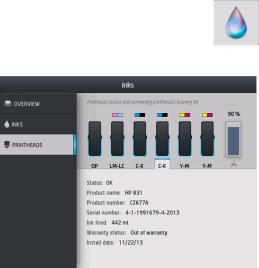
●Incorrect: The cartridge is not compatible with this printer. The message includes a list of compatible cartridges.
●Non-HP: The cartridge is used, refilled, or counterfeit.
You can also view the status of the ink cartridges in the Embedded Web Server. See Access the Embedded Web Server on page 23.
Check the status of a printhead
The printer automatically checks and services the printheads after each print. Follow these steps to get more information on your printheads.
1. On the front panel's home screen, press |
(HP Latex 365 and 375) or the printhead icon (HP Latex |
315 and 335).
2.Select the printhead for which you want to see information.
3.The front panel shows the following information:
●Status
●Product name
●Product number
●Serial number
●Ink fired
●Warranty status
●Install date
These are the possible printhead status messages that you can see on the front panel:
●OK: The printhead is working normally, with no known problems.
●Missing: There is no printhead present, or it is not correctly installed in the printer.
●Reseat: You are recommended to remove the printhead and then reinsert it. If that fails, clean the electrical connections (see Clean the electrical connections on a printhead on page 144). If that fails, replace the printhead with a new printhead (see Replace a printhead on page 137).
●Replace: The printhead is failing. Replace the printhead with a working printhead (see Replace a printhead on page 137).
16 Chapter 1 Introduction |
ENWW |
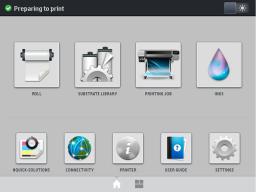
●Replacement incomplete: The printhead replacement process has not completed successfully; restart the replacement process and let it finish completely.
●Remove: The printhead is not a suitable type for use with your printer.
●Non-HP ink: Ink from a used, refilled, or counterfeit ink cartridge has passed through the printhead. See the limited warranty document provided with your printer for details of the warranty implications.
You can also use the Embedded Web Server to check the printhead status and the warranty status. See Access the Embedded Web Server on page 23.
Check the file system
It is possible to check the integrity of the file system on the printer's hard disk, and automatically correct any errors. You are recommended to do this about once every six months, or if you notice any trouble in accessing files on the hard disk.
To execute the file system check, go to the front panel and press  , then Preventive maint. tasks > File system check.
, then Preventive maint. tasks > File system check.
If the printer is aware of damage to the file system, for instance after a severe software problem, it may start a file system check automatically. This can take about ten minutes.
Printer alerts
The printer can communicate two types of alerts:
●Errors: When the printer is unable to print.
●Warnings: When the printer needs attention for an adjustment, such as a calibration, preventive maintenance, or ink cartridge replacement.
●Advice: When a firmware update is available or the downloaded firmware is ready to be installed. Printer alerts appear in the front panel and in the Embedded Web Server.
●Front-panel display: The front panel shows the alerts in the upper left part of the screen (notification bar).
Only one alert is shown at a time. If you press the notification bar, all the current printer alerts are shown. The list of alerts can be folded back by pressing or sliding up the bottom row of the list.
ENWW |
Front panel 17 |

Clicking an alert opens the application that could help to resolve it. Firmware update advice is dismissed when entering the Printer application. Once dismissed, there won’t be any reminder later on about the same advice (in the case of firmware updates, a new notification appears when there a new firmware release becomes available).
●Embedded Web Server: The Embedded Web Server shows only one alert at a time, which is judged to be the most important.
An alert may require you to perform a maintenance operation; see Hardware maintenance on page 129. The following alerts require a service engineer:
●Service Maintenance Kit 1
●Service Maintenance Kit 2
●Service Maintenance Kit 3
Printer states
The printer may be in any one of the following states; some of them require waiting.
●Ready (cold): The printer is powered on but has not printed yet, and the heaters are not turned on.
●Preparing to print: The printer is warming up the heaters and preparing the printheads to print. This takes 1 to 6 min.
●Ready for substrate
●Ready for side A/B
●Printing
●Printing side A/B
●Drying: This takes 1.5 to 5 min.
●Finishing: The printer is cooling down and preparing for stand-by. This takes 0.5 to 5 min.
You can select continuous printing using certified RIP software. Without continuous printing, the printer cures each job separately and then winds the substrate back into the print zone before starting to print the next job in the queue. This adds time to the printing process. Continuous printing saves time by continuing to print the next job in the queue without stopping (tailgating), if it uses the same print mode and resolution.
 NOTE: The same print mode and resolution must be used for all jobs in the RIP queue selected for continuous printing, to optimize the overall curing time.
NOTE: The same print mode and resolution must be used for all jobs in the RIP queue selected for continuous printing, to optimize the overall curing time.
 NOTE: When continuous printing is enabled, canceling a job could also cancel the subsequent job.
NOTE: When continuous printing is enabled, canceling a job could also cancel the subsequent job.
18 Chapter 1 Introduction |
ENWW |

Change margins
The printer margins determine the area between the edges of your image and the edges of the substrate. The 365 or 375 printer with ink collector is capable of printing with no side margins (full bleed).
The side margins for a particular print job are selected in the RIP software; if the job exceeds the substrate width, it will be clipped.
The front panel offers additional settings for the top and bottom margins: see Margins on page 175. These settings apply only to single prints when the cutter is not in use. The top and bottom margins are not applied during double-sided printing.
To set the top margin at the front panel, press  , then Substrate > Substrate handling options > Extra top margin.
, then Substrate > Substrate handling options > Extra top margin.
To set the bottom margin at the front panel, press  , then Substrate > Substrate handling options > Extra bottom margin.
, then Substrate > Substrate handling options > Extra bottom margin.
 NOTE: The extra top/bottom margin set in the front panel is applied in addition to the top/bottom margin selected in the RIP.
NOTE: The extra top/bottom margin set in the front panel is applied in addition to the top/bottom margin selected in the RIP.
 NOTE: The side margins can be adjusted in the RIP.
NOTE: The side margins can be adjusted in the RIP.
Request the printer’s internal prints
The internal prints provide various kinds of information about your printer. Request these prints from the front panel, without using a computer.
Before requesting any internal print, make sure that substrate is loaded and that the Ready message appears on the front-panel display.
To print an internal print, press  , then Setup > Internal prints, then select the type of internal print that you want.
, then Setup > Internal prints, then select the type of internal print that you want.
The following internal prints are available:
●Usage report: Shows estimates of the total number of prints, number of prints by substrate family, number of prints by print-quality option, and total amount of ink used per color. The accuracy of these estimates is not guaranteed.
●Service information: Provides information that service engineers require.
Check lifetime usage statistics
There are two ways of checking your printer's usage statistics.
 NOTE: The accuracy of the usage statistics is not guaranteed.
NOTE: The accuracy of the usage statistics is not guaranteed.
●From the Embedded Web Server, go to the Main tab and select History > Usage. See Embedded Web Server on page 22.
●From the front panel, press  , then Setup > Internal prints > User information prints > Print usage report.
, then Setup > Internal prints > User information prints > Print usage report.
ENWW |
Front panel 19 |
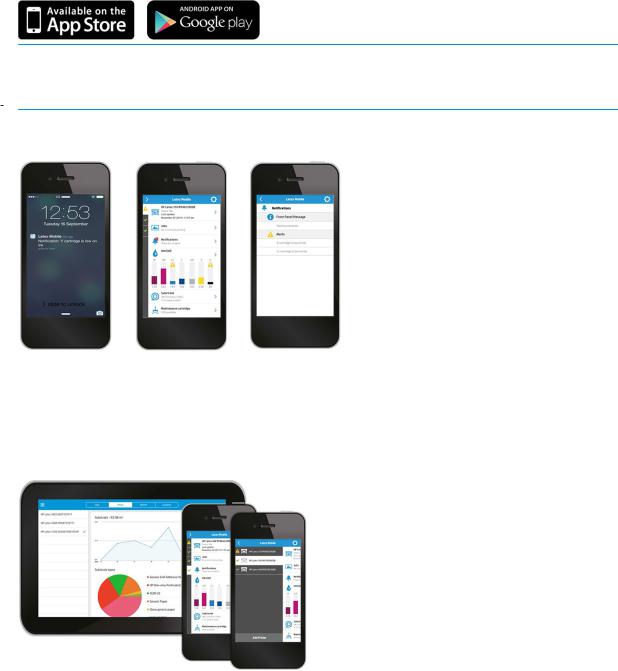
HP Latex Mobile
Your printer supports a new application called HP Latex Mobile, which marks a new era of smart printers. This app enables you to receive helpful consumables alerts while remotely monitoring your printer and job status on your smartphone or tablet. It also compiles metrics related to ink and substrate usage and productivity that you can view from your tablet. Print with greater confidence, especially as you no longer have to worry about the status of print jobs while you’re away from the printer.
 NOTE: HP Latex Mobile is compatible with Android 4.1.2 or later and iOS 7 or later, and requires the printer and the smartphone or tablet to be connected to the Internet.
NOTE: HP Latex Mobile is compatible with Android 4.1.2 or later and iOS 7 or later, and requires the printer and the smartphone or tablet to be connected to the Internet.
 NOTE: Metrics are available on tablets but not on smartphones.
NOTE: Metrics are available on tablets but not on smartphones.
Rely on alerts to tell you when attention is needed
No more wondering what’s going on with your printer while you’re away:
●Alerts keep you informed about supplies, the substrate path, and situations when the printer is not ready.
●Return to your printer and take action once you’ve been alerted.
Know the status of your printer while you’re away from it
HP Latex Mobile offers insight into printer activity and ink and substrate usage:
●Follow printer activity remotely and gain an awareness of your printer at all times.
●Stay abreast of ink levels and the amount of substrate remaining to avoid surprises and respond accordingly.
●Use your tablet to view metrics. Email that information to your computer for more details of ink and substrate usage as well as productivity per printer or job. Use it to improve planning and operations.
20 Chapter 1 Introduction |
ENWW |
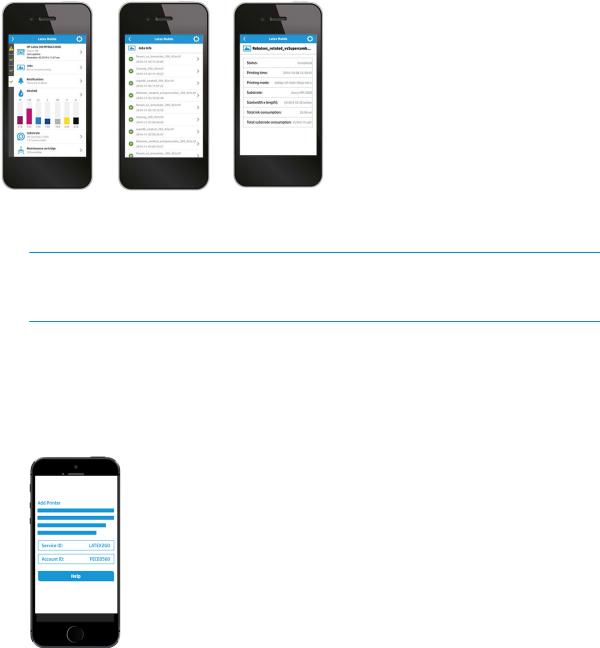
Remotely keep tabs on print jobs
HP Latex Mobile enables you to monitor job completion and job history:
●Track print jobs through to completion.
 NOTE: Printer updates occur roughly every five minutes during the printing process and every several hours when the printer is idle. Under certain circumstances, printer updates may be delayed—when system errors occur, for certain substrate jams, in the case of a power outage—in which case the app dashboard display shows the last known printer status.
NOTE: Printer updates occur roughly every five minutes during the printing process and every several hours when the printer is idle. Under certain circumstances, printer updates may be delayed—when system errors occur, for certain substrate jams, in the case of a power outage—in which case the app dashboard display shows the last known printer status.
●Monitor printed jobs through the job history.
How to add a printer to your mobile device
1.Open the HP Latex Mobile app on your mobile device.
2.Select Add new HP Latex Printer.
3.Make a note of the Service ID and Account ID.
4.Go to the printer’s front panel and press  , then Setup > Printer Data Sharing Agreement.
, then Setup > Printer Data Sharing Agreement.
5.Continue until you see the options Yes, I want to participate, Also send the printer’s serial number, and Also send data to printer services. Select them all.
6.Register a new service and enter the Service ID and Account ID from your mobile device.
7.Press Continue and Accept until the registration is finished.
Alternatively, you can use the Embedded Web Server instead of the front panel.
1.In the Embedded Web Server, select the Printer Data Sharing Agreement tab.
2.Check Yes, I want to participate (send anonymous data only).
ENWW |
HP Latex Mobile 21 |

3.Check Also send the printer’s serial number.
4.Check Also send data to printer services.
5.Check Register for a new service.
6.Enter the Service ID and Account ID from your mobile device and click Register.
7.The next screen tells you that the HP Latex to Go service will send status data from the printer to the connected devices through the Internet. Click Accept.
Embedded Web Server
Introduction to the Embedded Web Server
The Embedded Web Server is a Web server running inside the printer. You can use it to obtain printer information, manage settings and presets, align printheads, upload new firmware and troubleshoot problems. Service engineers can use it to retrieve internal information that helps to diagnose printer problems.
You can access the Embedded Web Server remotely by using an ordinary Web browser running on any computer. See Access the Embedded Web Server on page 23.
The Embedded Web Server window displays three separate tabs. Buttons near the top of each page provide access to online help and supplies reordering.
22 Chapter 1 Introduction |
ENWW |
Main tab
The Main tab provides information about the following items.
●Substrate, ink, printhead and maintenance status
●Temperature of the curing module
●Substrate and ink usage and accounting
Setup tab
The Setup tab enables you to complete these tasks.
●Specify printer settings such as units of measurement and refresh date
●Specify network and security settings
●Set the date and time
●Update firmware
●Align printheads
●Upload substrate presets
●Configure e-mail notifications
Networking tab
The Networking tab enables you to change the printer’s networking configuration.
Printer Data Sharing Agreement tab
The Printer Data Sharing Agreement tab enables you to sign the Printer Data Sharing Agreement and configure your participation.
Support tab
The Support tab offers various kinds of help with your printer.
●Browse helpful information from a variety of sources
●Troubleshoot problems
●Access HP links for technical support with your printer and accessories
●Access service support pages that show current and historical data on the usage of your printer
Access the Embedded Web Server
Use the Embedded Web Server to view printer information remotely through an ordinary Web browser running on any computer.
The following browsers are known to be compatible with the Embedded Web Server:
●Internet Explorer 7 and later for Windows
●Safari 3 and later for Mac OS X
●Mozilla Firefox 3.6 and later
●Google Chrome 7 and later
ENWW |
Embedded Web Server 23 |

To use the Embedded Web Server on any computer, open your Web browser and type the printer's IP address in the browser's address bar. The printer's IP address appears on the printer’s front panel, after pressing the  icon.
icon.
If you follow these instructions but fail to open the Embedded Web Server, see Cannot access the Embedded Web Server on page 164.
Change the language of the Embedded Web Server
The Embedded Web Server functions in the following languages: English, Portuguese, Spanish, Catalan, French, Italian, German, Simplified Chinese, Traditional Chinese, Korean, and Japanese. It uses the language that you specified in your Web browser options. If you specify a language that it cannot support, it functions in English.
To change the language, change your Web browser's language setting. For example, in Chrome, Settings, Language (in the advanced settings view), make sure that the language you want is at the top of the list in the dialog box; or, in Internet Explorer version 8, go to the Tools menu and select Internet Options > Languages. Make sure that the language you want is at the top of the list in the dialog box.
To complete the change, close and reopen your Web browser.
Restrict access to the printer
From the Embedded Web Server, you can select Setup > Security to set an administrator password. Once set, this password must be given in order to perform the following printer functions.
●Clear accounting information.
●Update the printer’s firmware.
●Change security settings.
●View protected printer information.
●Change Internet connection settings.
●Change some networking settings.
●Configure the Printer Data Sharing Agreement.
●Run connectivity troubleshooting tests.
For more information, see the Embedded Web Server's online help.
If you forget the administrator password, you can delete the current password from the front panel: press  , then Setup > Connectivity > Advanced > Embedded Web Server > Reset EWS password.
, then Setup > Connectivity > Advanced > Embedded Web Server > Reset EWS password.
Join the Printer Data Sharing Agreement
You can activate or deactivate the Printer Data Sharing Agreement from the Embedded Web Server or from the printer's front panel.
NOTE: From the front panel, press  , then Setup > Printer Data Sharing Agreement.
, then Setup > Printer Data Sharing Agreement.
The Printer Data Sharing Agreement is a statistical printer-usage tracking system. It may also be used to determine eligibility for certain usage-based reward programs, or to monitor the device in connection with optional services such as proactive cartridge replacement, pay-per-use contracts, or support agreements (availability varies by product, region, and country). See the Printer Data Sharing Agreement tab of the Embedded Web Server for details on the data collected and HP’s use of the data. Once the Printer Data Sharing
24 Chapter 1 Introduction |
ENWW |
